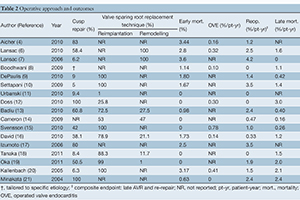Systematic review of aortic valve preservation and repair
Abstract
Background: Aortic valve repair has emerged as a feasible alternative to replacement in the surgical treatment of selected patients with aortic valve (AV) pathology. In order to provide a synopsis of the current literature, we preformed a systematic review with a focus on valve-related events following AV repair.
Methods: Structured keyword searches of Embase and PubMed were performed in January 2012. A study was eligible for inclusion if it reported early mortality, late mortality, or valve-related morbidity in the adult population.
Results: Initial search results identified 3,507 unique studies. After applying inclusion and exclusion criteria, 111 studies remained for full-text review. Of these, 17 studies involving 2,891 patients were included for quantitative assessment. No randomized trials were identified. Tricuspid and bicuspid AV pathologies were present in 65% (range, 21-100%) and 13.5% (range, 5-100%) of the population, respectively. Cusp repair techniques were applied in a median of 46% (range, 5-100%) of patients. The median requirement for early reoperation for post-operative bleeding and early reintervention for primary AV repair failure was 3% (range, 0-10%) and 2% (range, 0-16%), respectively. Pooled early mortality was 2.6% (95% CI: 1.4- 4.4%, I2 =0%). Late mortality and valve-related events were linearized [(number of events/number of patient-years) ×100] (%/pt-yr) for each study. Late operated valve endocarditis was reported at median event rate of 0.23%/pt-yr (range, 0-0.78%/pt-yr), while a composite outcome of neurological events and thromboembolism occurred at a median rate of 0.52%/pt-yr (0-0.95%/pt-yr). Late AV re-intervention requiring AV replacement or re-repair occurred at a rate of 2.4%/pt-yr (range, 0-4.2%/pt-yr). The median 5-year freedom from AV re-intervention and late recurrent aortic insufficiency >2+ estimated from survival curves was 92% (range, 87-98%) and 88% (range, 87-100%), respectively. Pooled late mortality produced summary estimate of 1.3%/pt-yr (95% CI: 0.9-2.1%, I2=0%).
Conclusions: The present systematic review confirmed the low operative risk of patients who underwent aortic valve preservation and repair. There is a need for long-term follow-up studies with meticulous reporting of outcomes following AV repair, as well as comparative studies with aortic valve replacement.
Cover






